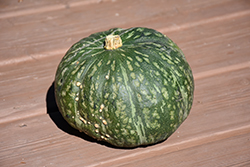Fri & Sat 8am - 8pm
Sun 8am - 7pm
Anytown, USA 12345
fax: 261.787.0463
e-mail: info@successgc.com


Plant Finder

Height: 18 inches
Spacing: 18 inches
Sunlight:
![]()
Hardiness Zone: (annual)
Group/Class: Winter Squash
Description:
A compact selection perfect for small gardens; produces good yields of squat-round, gray-green fruit with gray stripes and mottling; extra fine, bright orange flesh is delicious and nutty when baked or roasted; an excellent single serving sized portion
Edible Qualities
Shokichi Green Mini Kabocha Squash is an annual vegetable plant that is commonly grown for its edible qualities. It produces small dark green round fruit with gray variegation and orange flesh which are usually ready for picking from late summer to mid fall. The fruits have a pleasant taste.
The fruit are most often used in the following ways:
- Cooking
- Baking
- Freezing
Planting & Growing
Shokichi Green Mini Kabocha Squash will grow to be about 18 inches tall at maturity, with a spread of 4 feet. When planted in rows, individual plants should be spaced approximately 18 inches apart. This vegetable plant is an annual, which means that it will grow for one season in your garden and then die after producing a crop.
This plant is typically grown in a designated vegetable garden. It should only be grown in full sunlight. It does best in average to evenly moist conditions, but will not tolerate standing water. It is not particular as to soil pH, but grows best in rich soils. It is somewhat tolerant of urban pollution. Consider applying a thick mulch around the root zone over the growing season to conserve soil moisture. This is a selected variety of a species not originally from North America, and it is considered by many to be an heirloom variety.; however, as a cultivated variety, be aware that it may be subject to certain restrictions or prohibitions on propagation.
